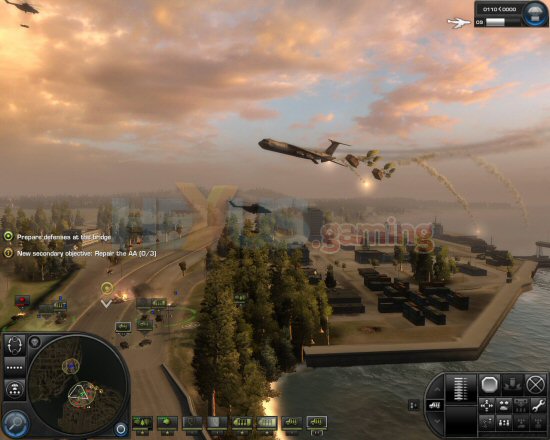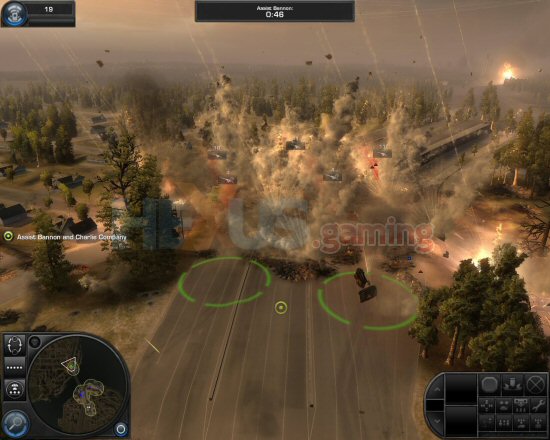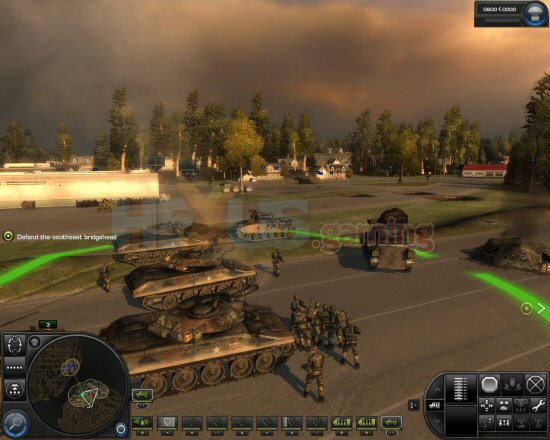Let's get in the game!
The units themselves are made split into four distinct military roles. You’ve got infantry which gives you basic infantry, anti-tank units, APCs and Hum-vees. Then there’s heavy armour in the shape of light to heavy tanks and anti-aircraft batteries. Next up is the artillery, which are probably the most useful units in the entire game and finally you’ve got your air units with scout helicopters through to heavy attack tank-busting Apaches.As is usual for an RTS, units are best suited to particular purposes and have inherent strengths and weaknesses. Anti-tank infantry are excellent for destroying even the toughest enemy armour but move so slowly that you’ll be hard pressed to clear the area if the enemy send in an artillery barrage. Tanks are good all-round attack and defence units but are nearly defenceless against helicopters. Artillery is superb for utterly obliterating the landscape and the enemy but have no close defence weaponry of any sort… All of which means that with your limited reinforcements, you have to plan very carefully and use a mix of units to make up for each others’ weaknesses.
 Click for larger image
Click for larger imageMost of the units under your command have special abilities, all accessible either from the unit order palette in the bottom right of the screen or by holding down the E key and then clicking on the game terrain or target. If you’ve selected a group of mixed units you can cycle through all the available abilities for the group as a whole before choosing one, something that you’d be well advised to get used to as it really will make a difference, especially on normal or hard settings.
You’re not on your own in many of the missions though as you can call on artillery and air support from the tactical aid menu. In a similar way to the reinforcement points, tactical aid points build over time, allowing you to access more frequent and more powerful forms of air and artillery support. But how quickly these points build up is dependent on your performance. Sit back and defend and you’ll get nothing, push forward and attack and the points will build up.
 Click for larger image
Click for larger imageThere’s a very strong story element to World in Conflict that not only gives you loads of cut scenes between missions but also drives your objectives in the mission itself. It’s worth mentioning the rather unique style of the between mission segments, which are static screens in an ‘oil on canvas’ style that highlight individual soldier’s stories as troops call loved ones during lulls between battles. Some of these are quite poignant and serve to humanise the characters and otherwise faceless units in the game… though it would’ve been nice to have seen some stories from the Russian side too.
Each mission is preceded by a motion captured cut scene which gives you an overall view of the campaign as a whole and the purpose behind your mission. As you battle through, the game will occasionally be interrupted by brief cut scenes to give some more story or fly-overs to highlight your next objective. Whilst keeping you in touch with the overall picture of the war, the fly-by can be frustrating as it interrupts the action and, more annoyingly, resets your camera view… a real pain if you’re in the middle of re-organizing your squads. But that really is a minor niggle as they are key in keeping you focused on what you have to do and you do get used to them after a few missions have gone by.
 Click for larger image
Click for larger imageIn each mission you’ll be asked to complete a series of primary objectives as well as a few secondary ones. The secondary objectives aren’t mission critical but are hugely satisfying to complete, especially if you’re playing on hard. Most objectives are signified by command points, small areas on the map that you must occupy first by driving off the enemy.
Often, these command points are around a strategic area and so are linked together. You can only capture the objective by placing units in all the linked command points but once you’ve done this the command points will automatically start to build fortifications around themselves, such as machine gun nests, RPG bunkers and anti-aircraft sites. How quickly these are built depends on how many units you have in each command point, so that’s always a good time to reinforce and get your troops in there. Once that’s done and the fortifications are in place, you can roll off to your next objective.
 Click for larger image
Click for larger imageNow don’t go thinking for one minute that you can play World in Conflict at your own pace as often this just isn’t the case. This is a fast moving, mobile war you’re involved in and you’re not alone on your side of the army. You’ve got Colonel Sawyer, your overall commander giving you objectives and advice throughout the mission, then there’s Webb, who plays mainly a support role in backing you up after intense actions and Bannon, a loose-cannon tank commander. Throughout every mission you’ll be listening to radio chatter and talk back and forth between these three which not only clues you in to what’s going on elsewhere but also gives you direction in what you’ve got to do next.
Massive’s clever use of cut scenes comes into play here to give you some back story on the relationship between your three fellow officers. As you play through the game you’ll come to understand why Bannon is a bit of a dick and why Colonel Sawyer can’t stand him. Webb is a thorough, cool headed leader who offers helpful advice in the face of Sawyer’s seemingly over-ambitious and sometimes near-reckless battle plans. And all of this is in addition to the superb gameplay action itself.









